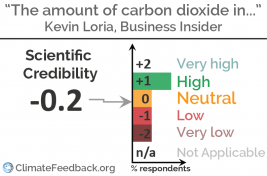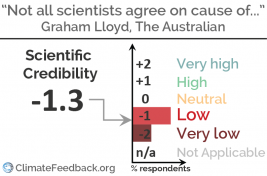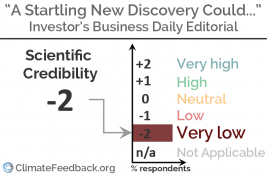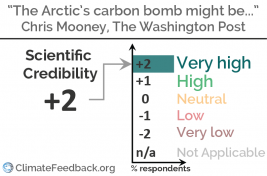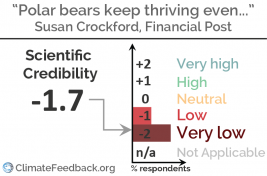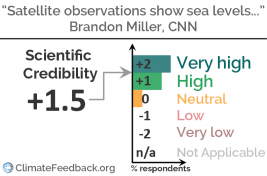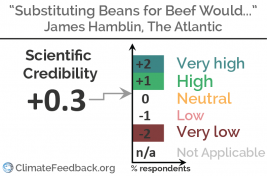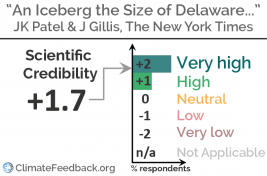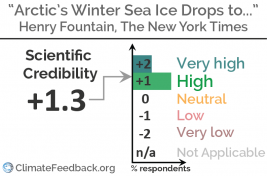Article Reviews
“Is this article consistent with the latest thinking and knowledge in science?”
“Would experts in this field endorse the main message of this article?”
These are the types of questions our “feedbacks” are designed to answer. If the feedback is positive, you can generally assume the information you’re reading is of high credibility. If it’s negative, however, you may want to read with extra care and attention — some of the information contained and conclusions reached are not consistent with science.[1]
Business Insider highlights health impacts of climate change, but some aspects are misleading
in Business Insider, by Kevin Loria
"The article draws attention to the high CO2 at present and the health risks of climate change, but it gives the incorrect impression that breathing CO2 directly is a major cause of concern. The most important health effects of climate change—heat stress, vector-borne diseases, air pollution, access to food and water, severe storms, displacement—do get some discussion here."
— 15 May 2018
The Australian’s coverage of Great Barrier Reef study creates perception that scientists are divided
in The Australian, by Graham Lloyd
"The Australian chooses to present a mixed message on this story when the science is extremely clear. The title and quote from Prof. Kaempf do not represent the views of the broader scientific community."
— 22 Apr 2018
Investor’s Business Daily editorial misrepresents study to claim plants will prevent dangerous climate change
in Investors' Business Daily, by Anonymous
"Our nitrogen study does not detract from the urgency of the climate problem, nor the unequivocal evidence of the role of carbon pollution in causing global climate change. The climate threat is clear and present and we must solve it rapidly by reducing emissions and capturing existing CO2 from the atmosphere."
— 12 Apr 2018
Washington Post accurately covers permafrost study, albeit under a somewhat sensational headline
in The Washington Post, by Chris Mooney
The article accurately described a study indicating that more of the carbon released from thawing permafrost will be released as methane and provided context on its overall implications by quoting comments from two other researchers. The article’s headline, however, may mislead readers through the use of the sensational phrase “the Arctic’s carbon bomb”, which calls to mind a catastrophic, explosive release of greenhouse gas.
— 22 Mar 2018
Financial Post publishes misleading opinion that misrepresents science of polar bears’ plight
in Financial Post, by Susan Crockford
"The article is composed of misstatements. These are either based upon the author’s apparent lack of understanding of the ecological and geophysical situations, or intent to mislead readers."
— 02 Mar 2018
New satellite measurements show sea level rise is accelerating, as CNN accurately reports
in CNN, by Brandon Miller
"Global geological sea-level data, data from tide gauge and now satellite data all show that the rate of sea level rise is accelerating. These accelerations in sea level is a cause for great concern."
— 15 Feb 2018
National Geographic video of starving polar bear should have clarified uncertain link to climate change
in National Geographic, by Sarah Gibbens
"The article contains valid information on the devastating consequences of climate change on polar bears. The only problem as I see it is that the article presents (implicitly) that the polar bear in the video is dying as a consequence of climate change and from not finding enough food due to lack of sea ice..."
— 17 Jan 2018
Atlantic story on the climate implications of reduced beef consumption could provide clearer context
in The Atlantic, by James Hamblin
"The article explains the issue (meat production diverts crops from humans to cattle) on a simple level. More explanation and more context could have been provided, I think, regarding individual-level and sectoral sources of greenhouse emissions."
— 17 Jan 2018
New York Times effectively informs readers about large Larsen C iceberg calving event
in The New York Times, by Jugal K. Patel and Justin Gillis
"The article handles a complex topic well. It would be easy to be alarmist with this subject matter, and while its lede edges that way, the main content of the article is very balanced. It also presents a lot of interesting information in a compelling manner."
— 17 Jan 2018
New York Times accurately covers 2017 record low Arctic winter sea ice extent
in The New York Times, by Henry Fountain
"The article accurately reports on the state of Arctic sea ice at the annual maximum (in March) and its causes, and gives an insightful discussion as to the implications. There is one point which may be misleading..."
— 16 Jan 2018
[1] Note: These feedbacks do not constitute endorsements of the author’s political or economic ideology, rather they are assessments of the scientific foundations and reasoning of the argumentation contained within each article.

